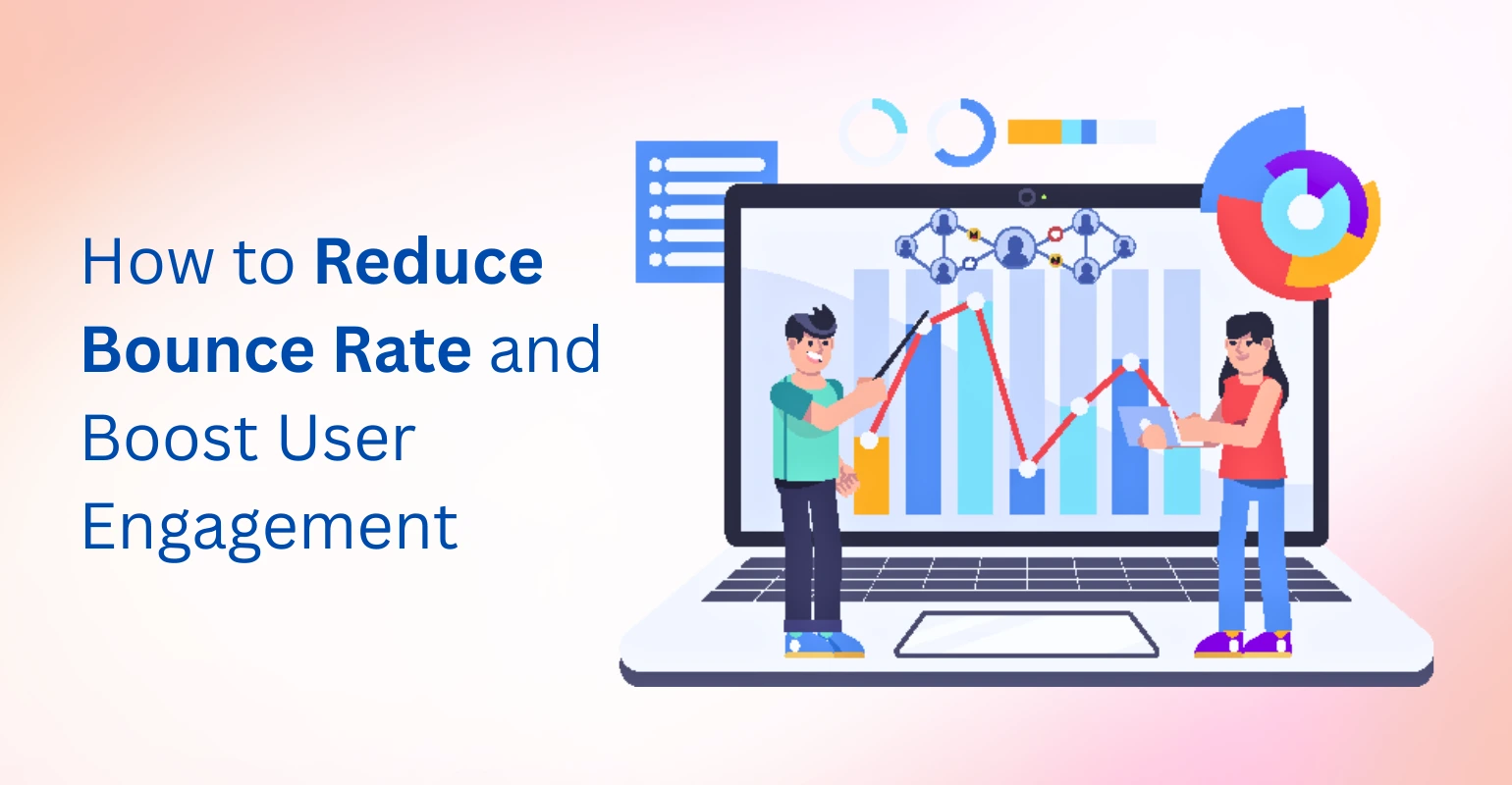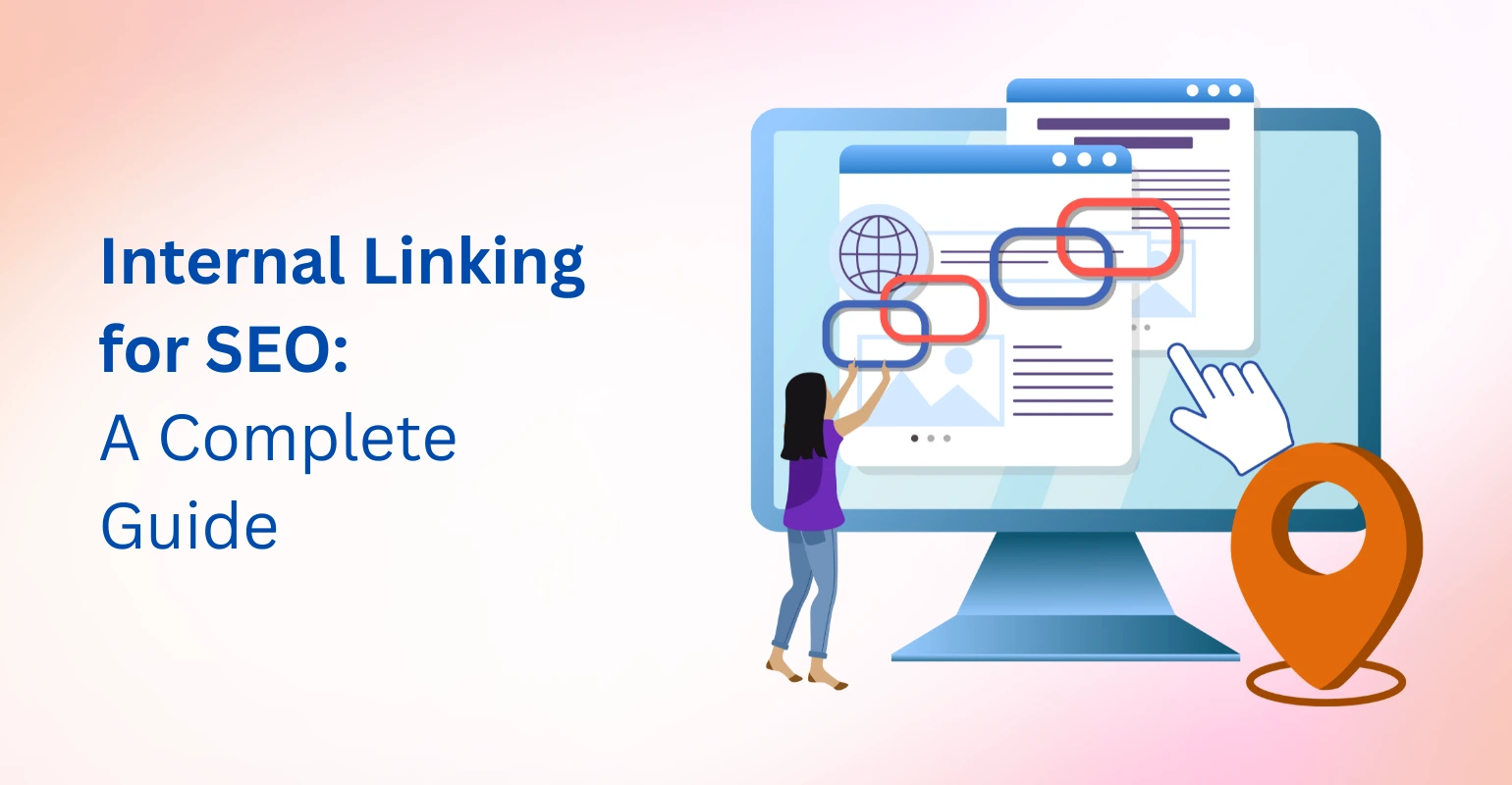blog
How to Reduce Bounce Rate and Boost User Engagement

A high bounce rate can quietly damage your website’s SEO success. You might be attracting visitors through SEO, ads, or social media. But if they leave without engaging, your effort and money go to waste.
Bounce rate shows the percentage of users who land on a page and exit without any interaction. It could be leaving without clicking a link, filling a form, or scrolling further. A high bounce rate signals poor engagement or user dissatisfaction.
The good news is that you can reduce bounce rate with the right approach. Small improvements in user experience and content design make a big difference. Reducing bounce rate helps you improve engagement, increase dwell time, and generate more conversions. It also strengthens your SEO and boosts visibility on Google.
This guide explains step-by-step how to reduce bounce rate effectively. You will learn what causes visitors to leave and how to fix it. Each strategy shared here is practical, data-backed, and aligned with Google’s latest ranking systems.
Let’s explore how you can keep users engaged, satisfied, and returning to your site.
What Is Bounce Rate and Why It Matters for SEO
Bounce rate is one of the most important website performance metrics. It shows how well your site captures user attention. When users visit a page and leave without interacting, it counts as a bounce. In other words, they came, viewed, and left.
In Google Analytics 4 (GA4), bounce rate is now replaced by engagement rate. The new metric focuses on meaningful user interactions. It measures how long visitors stay and whether they scroll or click within your page. A high bounce rate usually means your content does not match user intent. It could also signal slow loading, poor UX, or weak relevance.
| Website Type | Good Bounce Rate | Average | Poor |
|---|---|---|---|
| Blogs / News | 60–80% | 81–90% | 90%+ |
| E-commerce | 30–50% | 51–60% | 60%+ |
| Service Websites | 30–45% | 46–55% | 55%+ |
| Landing Pages | 40–50% | 51–65% | 65%+ |
However, not all bounce rates are bad. The ideal percentage depends on the type of website:
- Blogs often have higher bounce rates (60–80%). Readers may get their answers and leave satisfied.
- E-commerce websites should aim for under 40–50%. Low bounce means visitors are browsing or buying.
- Service-based websites perform best at 30–45%. This shows visitors explore deeper or make inquiries.
Understanding bounce rate helps you identify weak spots in user experience. Once you know why visitors leave, you can fix it. Analyze factors like page speed, content quality, and intent alignment. Making small, data-driven improvements can quickly reduce bounce rate and enhance user engagement.
A lower bounce rate leads to longer visits, better conversions, and stronger SEO performance.
Top Reasons Why Your Bounce Rate Is High
Before you fix the problem, you need to diagnose it. Let’s look at the most common reasons visitors leave your site quickly:
1. Slow Page Loading Speed
According to Google, 53% of users abandon a page if it takes longer than 3 seconds to load. Heavy images, poor hosting, or unoptimized scripts all slow your site down. Use PageSpeed Insights or GTmetrix to analyze and fix performance issues.
2. Poor Mobile Optimization
Over 65% of global traffic now comes from mobile devices. If your site isn’t mobile-friendly; with small fonts, misaligned elements, or hard-to-tap buttons, users will exit immediately.
3. Misleading Meta Titles and Descriptions
When your title promises one thing, but the page content delivers another, visitors feel misled. Always align your meta tags with the actual value offered on your page.
4. Weak or Irrelevant Content
Thin content that fails to provide answers leads to high bounce rates. Use data, examples, visuals, and expert commentary to build trust and relevance.
5. Bad UX and Intrusive Pop-ups
Overwhelming ads, auto-playing videos, and confusing navigation drive users away fast. Simplify your layout and make it intuitive.
In short, if you want to reduce bounce rate, start by identifying what’s pushing users to leave.

Image Source: Created using Napkin AI.
Proven Strategies to Reduce Bounce Rate and Keep Visitors Engaged
Now that you know the causes, let’s focus on how to fix them. These proven, real-world strategies will help you reduce bounce rate and make visitors stay longer on your website.
1. Improve Page Speed and Technical Performance
Speed is a direct reflection of user experience.
- Compress and resize images without losing quality.
- Use caching plugins or CDNs to deliver content faster.
- Minimize redirects and unused JavaScript.
- Test regularly using Google Lighthouse or GTmetrix.
A one-second delay in load time can lower conversions by 7%, so this step alone can dramatically reduce bounce rate.
2. Optimize Above-the-Fold Content
The section users see first determines whether they scroll further or not. Keep your above-the-fold area engaging with:
- A clear, value-driven headline
- An eye-catching hero image or short explainer video
- A strong CTA or reason to keep reading
3. Make Content Readable and Interactive
Walls of text are intimidating. Use short paragraphs, bullet points, and subheadings (H2s and H3s) to improve readability. Add infographics, charts, or even polls to make your content interactive. Embedding relevant videos or case studies can also boost dwell time – a metric that complements bounce rate reduction.
4. Ensure Mobile-Friendliness
Responsive design isn’t optional anymore. Test your pages across multiple devices using Google’s Mobile-Friendly Test. Your site should load fast, look clean, and be easy to navigate on every screen size.
5. Match Content to Search Intent
If users come to your page expecting an answer and don’t get it immediately, they’ll leave. Align your content with the search intent behind each keyword.
For example:
- Informational intent: In-depth guides, tutorials, how-tos
- Transactional intent: Product or service pages with CTAs
- Navigational intent: Brand-specific or directional searches
When content matches intent, bounce rates drop naturally.
6. Improve Internal Linking
Guide readers to relevant content with contextual links. For example, link related articles such as “Technical SEO Basics” or “Dwell Time in SEO”. Internal links help distribute link equity and encourage visitors to explore more, reducing bounce rate while improving crawl depth.
7. Add Clear Calls-to-Action (CTAs)
CTAs give visitors a reason to engage further, download a guide, sign up for a newsletter, or book a consultation.
Avoid generic buttons like “Click Here.” Instead, use action-focused phrases like:
- “Discover Proven SEO Tips”
- “Download the Free Checklist”
- “Get Your SEO Audit Now”
8. Use Heatmaps and Behavior Analytics
Tools like Hotjar, Microsoft Clarity, and Crazy Egg let you visualize user behavior, where they click, scroll, or drop off. This data helps identify which elements to adjust to reduce bounce rate effectively.
9. Build Trust and Credibility
Trust is a key EEAT factor. Add author bios, real testimonials, SSL certification, and credible external sources. When users trust your site, they’re more likely to stay longer.
10. Update Old Content Regularly
Outdated content leads to user drop-offs. Keep your blogs fresh with current stats, recent examples, and updated visuals. Regularly refreshing your articles shows Google that your content is relevant and authoritative; two qualities that naturally lower bounce rates.
How Content Quality and Relevance Impact Bounce Rate
High-quality, relevant content is the foundation of a strong website experience and the most effective way to reduce bounce rate. When visitors find genuine value in your content, they spend more time exploring your site, engage with multiple pages, and are more likely to convert.

Image Source: Created using Napkin AI.
Here’s how to build content that keeps users engaged:
- Write for humans first, algorithms second: Prioritize clarity, flow, and helpfulness. Search engines reward content that satisfies user intent.
- Back claims with credible data: Use real statistics, research reports, or expert quotes to strengthen trust and demonstrate authority.
- Maintain topical depth: Cover your subject comprehensively using LSI keywords like “improve dwell time,” “increase user engagement,” and “website retention.”
- Avoid clickbait headlines: Deliver on the promise of your title and match content to the reader’s intent.
- Make content actionable: Include step-by-step guidance, visuals, and internal links that encourage users to explore further.
When your content educates, engages, and solves real problems, it sends positive user signals to Google. Over time, these actions help improve SEO rankings, build brand authority, and naturally reduce bounce rate.
Tools to Analyze and Reduce Bounce Rate
To effectively reduce bounce rate, you must first understand what’s causing users to leave. The right analytics tools reveal where engagement drops, how users behave, and what needs improvement.
Here are some powerful tools to track and analyze bounce rate:
- Google Analytics 4 (GA4): Offers insights on engagement rate, average time on page, and pages per session.
- Google Search Console: Displays search performance, CTR, and queries that attract visitors, helping you match user intent better.
- Hotjar or Microsoft Clarity: Generate heatmaps and session recordings to visualize where users click, scroll, or abandon the page.
- Crazy Egg: Provides A/B testing features to experiment with headlines, layouts, or calls-to-action to enhance engagement.
- Ahrefs / SEMrush: Analyze keyword performance, traffic sources, and identify low-engagement pages.
| Tool | Best For | Free Version | Key Insight |
|---|---|---|---|
| Google Analytics 4 | Behavior metrics | Yes | Engagement rate, pages/session |
| Hotjar | Heatmaps | Yes | Scroll and click data |
| Clarity | Session recordings | Yes | Rage click analysis |
By combining quantitative data (like time on site or pages viewed) with qualitative insights (like click heatmaps), you gain a full picture of user behavior. These insights help you make targeted improvements that reduce bounce rate, enhance navigation, and improve overall website experience.
Advanced Tips to Reduce Bounce Rate for Different Website Types
Each website type demands a unique approach to improving engagement and lowering bounce rate. Here’s how to tailor strategies based on your site:
Blogs and Content Sites
- Add a clickable table of contents to improve navigation.
- Include “Read Next” or related articles to extend session duration.
- Use storytelling, visuals, and structured formatting to maintain interest.
E-commerce Websites
- Use high-quality product images, zoom-in features, and customer reviews.
- Simplify checkout flow and minimize form fields.
- Offer live chat support to address buying hesitation.
Service-Based Businesses
- Highlight expertise through case studies, client testimonials, and certifications.
- Add clear CTAs like “Book a Consultation” or “Get a Quote.”
- Showcase trust signals (awards, years of experience, partner logos).
Landing Pages
- Ensure ad copy and page content match user expectations.
- Limit distractions and use A/B testing for CTAs and headlines.
Different strategies suit different goals but the mission stays the same: create a seamless, trustworthy experience that reduces bounce rate and drives conversions.
Common Myths About Bounce Rate
Bounce rate is one of the most misunderstood SEO metrics. Many website owners panic when they see a high number, but not all bounces are bad. Let’s debunk a few common myths:
1. High bounce rate always means poor performance.
Not true. For blogs or single-page sites, a user might find what they need instantly and leave satisfied. That’s not a failure.
2. Visitors must click something to be engaged.
Wrong. If someone reads an article for five minutes without clicking, they’re still highly engaged GA4 measures this through “engagement rate.”
3. Reducing bounce rate guarantees higher rankings.
No metric works in isolation. Lowering bounce rate improves engagement, but SEO success also depends on quality, backlinks, and intent satisfaction.
4. Benchmarks are universal.
They vary by niche. A 70% bounce rate might be fine for blogs but terrible for e-commerce.
Before trying to reduce bounce rate, understand what it means for your audience and content type. Focus on intent alignment and satisfaction; not just the number.
Final Thoughts:
Reducing bounce rate isn’t about tricks, it’s about understanding your audience, delivering value, and creating an enjoyable on-page experience. From improving technical performance to writing relevant content, every small optimization adds up.
At Tangence, we specialize in helping businesses reduce bounce rate and improve engagement through data-driven SEO strategies, user experience audits, and content optimization. Our expert team analyzes user behavior, implements technical fixes, and crafts high-quality content that keeps your visitors hooked and your rankings strong.
Ready to optimize your website for engagement and conversions?
Contact Tangence to get a custom SEO strategy designed to boost your performance and grow your business sustainably.
Frequently Asked Questions
1. What is considered a good bounce rate for a website?
Generally, 26%–40% is excellent, 41%–55% is average, and anything above 70% requires attention. Benchmarks vary by niche.
2. Does reducing bounce rate improve SEO rankings?
Yes, indirectly. When you reduce bounce rate, user engagement and dwell time improve; both are positive signals for search engines.
3. How do I reduce bounce rate on my blog posts?
Enhance readability, add visuals, link to related posts, and ensure pages load fast.
4. Can a single-page website have a high bounce rate?
Yes, but it’s normal. Focus on engagement time instead of bounce rate for single-page sites.
5. What tools can help track and reduce bounce rate?
Use Google Analytics 4, Hotjar, Microsoft Clarity, or Ahrefs for behavior tracking and insights.
6. Is high bounce rate always bad?
Not necessarily. Sometimes users find what they need right away; such as a phone number or quick answer and leave satisfied.
7. How can Tangence help me reduce bounce rate?
Tangence provides SEO optimization, UX enhancement, and content marketing services tailored to lower bounce rates and boost conversions through evidence-based strategies.




